Having a Kohler toilet loud flush could indicate an internal problem, such as:
- Kohler toilet flapper not closing properly
- Faulty fill valve
- Damaged or worn-out Kohler toilet parts
- High water pressure
It is recommended to first check the fill valve and ensure it is unblocked & adjusted appropriately. In case, the water pressure is too high, lower it by adjusting the shut-off valve. If that does not work, inspect & replace the flush valve or flapper.
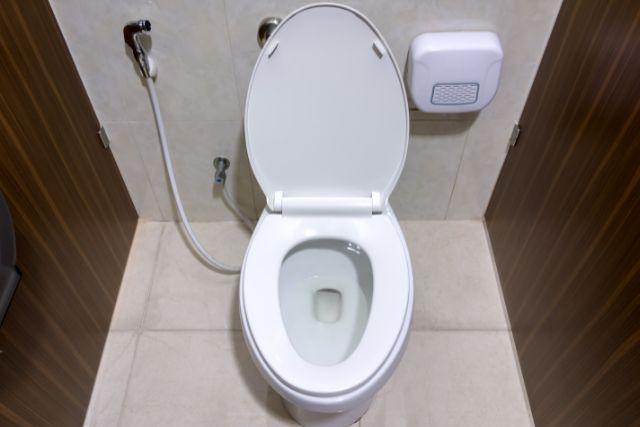
Here we will cover the causes and solutions to loud flushes in Kohler toilets, as well as tips on how to maintain them.
Whether you are a homeowner, or property manager, understanding the reasons behind a loud flush will save you time, money, and headaches.
Table of Contents
Quick Fixes Chart About Kohler Toilet Loud Flush:
| Problem | Causes | Solutions |
| 1. High Water Pressure | > Main supply water pressure problem > Faulty pressure regulator | > Install a pressure-reducing valve > Adjust Or replace the pressure regulator > Install water hammer arrestors > Contact the water provider |
| 2. Loose or damaged parts | > Malfunctioning Diaphragm > Valve Blockage or Debris | > Inspect and clean the fill valve > Adjust the fill Valve > Replace the fill valve. |
| 3. Kohler Toilet Flapper Not Closing Properly | > Damaged flapper | > Inspect the flapper > Clean or replace the flapper > Adjust the flapper chain |
| 4. Toilet or vent stack might be partially blocked | > Toilet is stuck with excessive toilet paper, foreign objects, or mineral deposits. > There is debris, bird nests, or ice buildup in the vent | > Clean out the toilet and vent stuck properly |
| 5. Damaged Or Worn Out Parts | > Loose or damaged parts | > Tighten Loose Parts > Replace Worn-out Parts > Consider Using Anti-vibration Pads > Seek Professional Assistance |
Kohler Toilet Loud Flush [Why + How To Fix]
Many Kohler toilet owners have reported a loud flushing noise that can be both annoying and embarrassing. Fortunately, there are five potential causes and solutions to this common problem. Let’s find out!
1. High Water Pressure
One of the common reasons for a loud flush in a Kohler toilet is high water pressure.
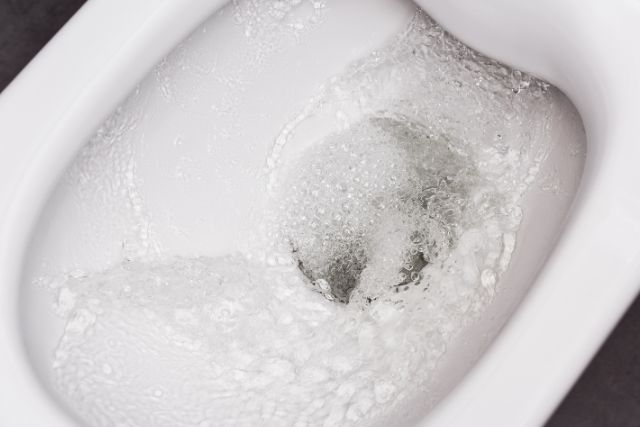
If the water pressure is too high, it can create a forceful flow of water during the flush. As a result, a loud noise is produced.
Possible Causes:
If you have a Kohler toilet with a loud flush due to high water pressure, here are some possible reasons to consider:
i) High Water Pressure from the Main Supply:
If the water pressure from the main supply is too high, it can lead to a loud and forceful flush in your Kohler toilet. Municipal water systems generally deliver water at a higher pressure. But if it’s not regulated, it can cause issues.
ii) Faulty Pressure Regulator:
Water pressure is controlled by a pressure regulator installed on the main water supply line. If the pressure regulator is faulty or not functioning properly, it can result in excessively high water pressure. As a result, the toilet flushes loudly.
Easy Fixes:
It is possible to solve this problem easily if you follow some of the suggestions listed below:
i) Install A Pressure-Reducing Valve (PRV):
This valve will help reduce the water pressure and ensure a more controlled and quieter flush. Here is the installation process of pressure reducing valve:
Step 1: Locate the main water shutoff valve and turn it off to cut off the water supply to your home. This ensures that no water is flowing through the pipes during the installation.
Step 2: Identify the section of the main water supply line where you want to install the pressure-reducing valve (PRV). Ensure that there is enough space and proper access for the valve.
Step 3: Use a pipe cutter or hacksaw to cut the main water supply line at the chosen installation location. Make a clean, straight cut to ensure a proper fit for the PRV.
Step 4: Connect the PRV to the cut ends of the water supply line. use appropriate fittings, ensuring a secure and leak-free connection. Use Teflon tape or pipe joint compound on threaded connections to create a tight seal.
Step 5: Once the PRV is properly connected, use adjustable wrenches to tighten the fittings. Ensure they are firmly in place. Check for any potential leaks around the connections.
Step 6: Turn on the main water supply valve to restore water flow to your home. Monitor the pressure and check for any leaks or issues with the PRV installation. According to the manufacturer’s instructions, adjust the PSV’s pressure using the adjustment screw or nut.
Precautions:
It’s important to note that the specific steps and requirements may vary. It depends on your plumbing system and the PRV model you’re using.
But, if you’re unsure about any aspect of the installation process, it’s recommended to consult a professional plumber. It’ll help with a proper and safe installation.
ii) Adjust Or Replace The Pressure Regulator:
If your home already has a pressure regulator, it may need adjustment or replacement if it’s not functioning correctly. Contact a professional plumber to inspect the pressure regulator and make any necessary adjustments or replacements.
iii) Install Water Hammer Arrestors:
A water hammer occurs when there is a sudden increase in water pressure, causing a loud banging noise. Installing water hammer arrestors on the water supply lines near the toilet. It can help absorb the shock and reduce the noise during flushing.
iv) Contact The Water Provider:
Please contact your water provider if you think high water pressure is solely due to the municipal water supply. They may be able to adjust the water pressure at the supply level to alleviate the problem.
Essential Note: It’s important to note that high water pressure also can cause other issues in your plumbing system, such as leaks or burst pipes. So, it’s crucial to address the issue promptly to prevent any potential damage.
2. Faulty Fill Valve
The fill valve is responsible for refilling the toilet tank after each flush. If the fill valve is faulty or worn out, it may not regulate the water flow properly. Consequently, the flush is loud and forceful.
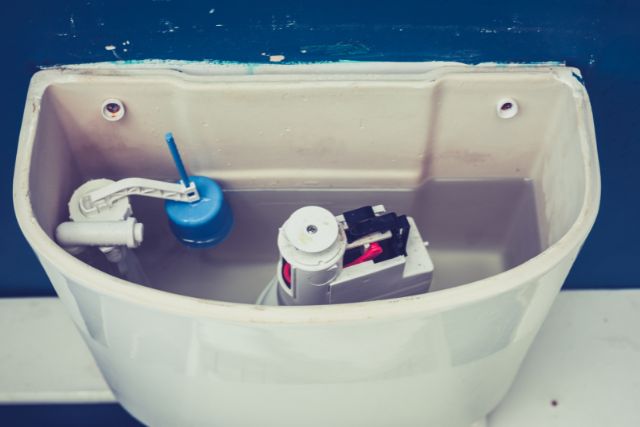
Possible Causes:
There are a couple of reasons why your Kohler toilet is flushing loudly due to a faulty fill valve:
i) Malfunctioning Diaphragm:
The fill valve in your toilet is equipped with a diaphragm that regulates the flow of water into the tank. If the diaphragm is worn out, damaged, or not functioning properly, it can cause irregular water flow.
ii) Valve Blockage or Debris:
The fill valve can become clogged with sediment, minerals, and debris over time. This can cause turbulence and noise during the flushing process.
Easy Fixes:
Here are some suggestions that will help you solve this problem easily:
i) Inspect And Clean the Fill Valve:
Start by shutting off the water supply to the toilet and flushing it to drain the tank. Remove the fill valve cap or cover. Inspect the diaphragm and other components for any signs of damage or debris.
Then, clean the valve thoroughly by flushing it with water or using a soft brush to remove any blockages. If the diaphragm is damaged, you may need to replace the fill valve entirely.
ii) Adjust The Fill Valve:
If the fill valve is still functioning, but the noise persists, you can try adjusting the water level. You can adjust the fill valve with a screw or rod, which controls the level of water in the tank. Try different settings to find the sweet spot that reduces flushing noise.
iii) Replace The Fill Valve:
If the fill valve is significantly damaged or cleaning and adjustments don’t resolve the issue, it’s best to replace the fill valve. Consult the toilet’s user manual or contact Kohler for the appropriate replacement fill valve.
Also, you can follow the manufacturer’s instructions to ensure proper installation and functionality.
Essential Note: If you’re not comfortable performing these steps yourself or the issue persists after attempting the solutions, it’s recommended to seek the assistance of a professional plumber. They have the expertise to diagnose and resolve the problem effectively.
3. Kohler Toilet Flapper Not Closing Properly
The flapper is responsible for sealing the tank and preventing water from continuously flowing into the bowl.
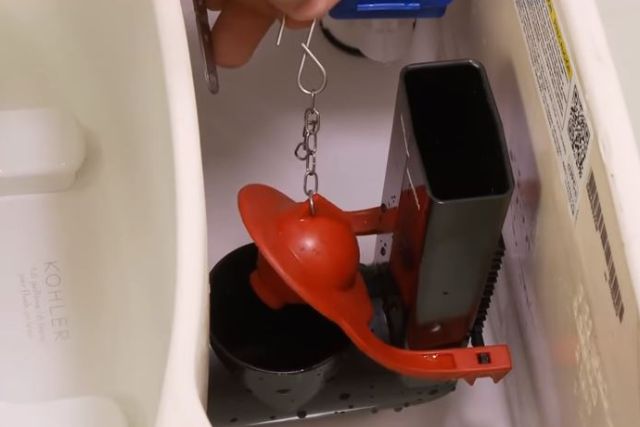
If the flapper is damaged, worn out, or misaligned, it may not close properly after a flush. This may lead to an excessive rush of water and loud noise during the flush.
Easy Fixes:
If your toilet flushes loudly as a result of a damaged flapper, here are some solutions:
i) Inspect The Flapper:
Start by turning off the water supply to the toilet and flushing it to drain the tank. Lift the toilet tank lid and inspect the flapper for any visible signs of damage, wear, or misalignment. Make sure the flapper is closed properly by checking for cracks, tears, or debris.
ii) Clean Or Replace The Flapper:
If the flapper is dirty or has debris on it, clean it using a soft brush and water. Ensure that there are no obstructions that prevent it from fully closing.
iii) Adjust The Flapper Chain:
The flapper is connected to the flush handle by a chain. If the chain is too loose or too tight, it can affect the proper closing of the flapper.
Make sure the chain has enough slack for the flapper to fully close without being too loose. Aim for a slight downward slope of the chain when the flapper is closed.
iv) Replace The Flapper
If the flapper is damaged or worn out, it’s best to replace it. Consult the toilet’s user manual or contact Kohler for the appropriate replacement flapper. Install the new flapper according to the manufacturer’s instructions.
v) Test the Flush:
After cleaning or replacing the flapper and adjusting the chain, turn on the water supply to the toilet and test the flush.
Ensure that the flapper closes smoothly and completely, without any water leakage or excessive noise. Make further adjustments if needed to achieve a quiet and effective flush.
4. The Toilet Or Vent Stack Might Be Partially Blocked
If there is a partial blockage in the toilet, it can restrict the flow of water during the flush, leading to loud noise. Common causes of toilet blockages include excessive toilet paper, foreign objects, or mineral deposits.
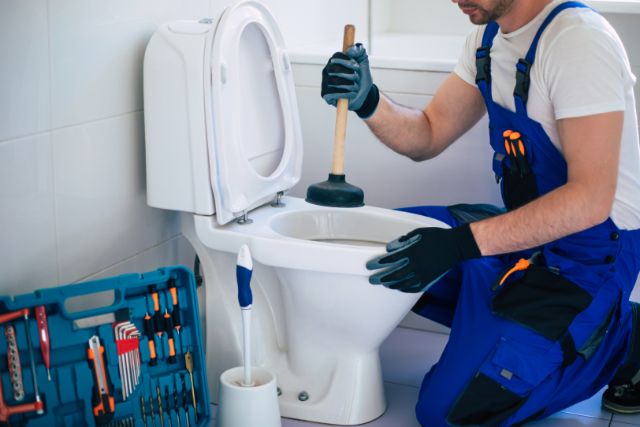
Therefore, the vent stack is a pipe that extends from the plumbing system to the roof, allowing air to enter and exit the plumbing system.
If the vent stack is partially blocked, it can disrupt the air pressure balance and cause a loud flush. Blockages in the vent stack can occur due to debris, bird nests, or ice buildup.
Easy Fixes:
i) Remove Toilet Blockage:
For removing a toilet blockage, you can try these things:
Use A Plunger:
Start by using a plunger to try and dislodge the blockage. Place the plunger over the drain hole and vigorously plunge up and down to create suction and remove the obstruction.
Toilet Auger:
If the plunger doesn’t work, a toilet auger can be used. Insert the auger into the toilet bowl and crank the handle to break up and remove the blockage. Follow the manufacturer’s instructions for proper use.
Chemical Drain Cleaner:
As a last resort, you can try using a chemical drain cleaner specifically designed for toilets. Follow the instructions on the product carefully and be cautious with their use, as they can be harsh and may damage the toilet if used improperly.
ii) Vent Stack Blockage:
Here are some tips for removing vent stack blockages:
Professional Assistance:
If you suspect a blockage in the vent stack, it is recommended to seek professional plumbing assistance. A plumber will have the necessary tools and expertise to locate and clear the blockage in the vent stack safely.
Roof Access:
In some cases, accessing the roof and visually inspecting the vent stack may reveal any visible blockages like debris or nests. However, it is not advised to attempt to clear the blockage without proper training or equipment.
5. Damaged Or Worn Out Toilet Parts
Various components within the toilet tank, such as bolts, nuts, or washers, can become loose or worn out over time.

These loose or damaged parts can cause rattling or vibrating sounds during flushing.
Easy Fixes:
There are a few things that you can do to help you resolve this problem as easily as possible:
i) Tighten Loose Parts:
Start by turning off the water supply to the toilet and removing the toilet tank lid. Inspect the flush valve, flapper, and other components for any loose connections. Use a wrench to tighten any loose nuts or bolts, ensuring they are securely fastened.
ii) Tighten The Refill Tube:
The refill tube is responsible for refilling the toilet tank with water after a flush. When it becomes loose, it can cause vibrations and noise during the flushing process.
You can tight the refill tube by following these steps:
Step- 1: Before making any adjustments, locate the shut-off valve behind or near the toilet and turn it clockwise to shut off the water supply to the toilet.
Step- 2 the toilet tank lid and locate the refill tube. It is a small flexible tube connected to the fill valve and usually extends into the overflow tube or overflow pipe.
Step- 3: Check if the refill tube is properly attached to the fill valve. It should be securely connected, with no loose or disconnected parts. If it is loose, reattach it by inserting it into the designated opening on the fill valve or clip provided
Step- 4: Ensure that the refill tube is positioned properly inside the overflow tube or overflow pipe. It should be inserted to a level that allows water to flow smoothly without any obstructions or kinks. Make any necessary adjustments to achieve this position.
Step- 5: Once the refill tube is securely attached and properly positioned, turn on the water supply by turning the shut-off valve counterclockwise. Allow the tank to fill completely, and then flush the toilet to check for any improvements in the noise level.
Step- 6: If the noise persists or the refill tube becomes loose again, repeat the steps above and ensure a secure attachment and correct positioning.
iii) Replace Worn-out Parts:
If the flapper or other components are visibly worn out, it’s best to replace them. Consult a professional plumber for guidance on the appropriate replacement parts and how to install them.
ii) Consider Using Anti-vibration Pads:
If the noise is caused by vibrations, you can try using anti-vibration pads under the toilet tank. These pads help absorb vibrations and reduce noise during flushing. Place the pads under the tank according to the manufacturer’s instructions.
iii) Seek Professional Assistance:
When in doubt, or if the problem persists after attempting the solutions above, it’s recommended to contact a plumber. They can accurately diagnose the issue, and replace any faulty components. Also, ensure a quiet and properly functioning flush.
Essential Note: Whenever you work with plumbing components, remember to turn off the water supply first. If you’re uncertain or uncomfortable with the process, it’s best to seek a professional. It helps to avoid causing further damage or creating potential safety hazards.
FAQs:
What Should I Do If My Kohler Toilet Flush Is Making A Whistling Sound?
A whistling sound during the flush is often caused by water flow restrictions. Check the fill valve and supply line for any blockages or obstructions. Adjusting the water pressure or cleaning out mineral deposits in the pipes may also help.
Is There A Way To Reduce The Noise Of My Kohler Toilet Flush?
Yes, there are a few steps you can take to minimize the noise of your Kohler toilet flush. Consider installing a fill valve with a built-in noise reduction feature. This can help reduce the sound of rushing water.
How Does Kohler Toilet Flush Valve Work?
The Kohler toilet flush valve operates by lifting a flapper or canister seal. It allows water from the tank to flow rapidly into the bowl. The sudden rush of water creates a siphoning effect, which empties the bowl and triggers the flush.
How Do You Quiet A Loud Toilet Flush?
To quiet a loud toilet flush, you can turn off the water supply, clean the fill valve to remove dirt and debris, flush out the valve line, and then turn the water back on. This should help eliminate the noise.
How Long Do Toilet Flush Valves Last?
A toilet flush valve typically lasts 6-7 years, while a fill valve lasts 4-5 years. Generally, these parts should be replaced periodically while retaining the toilet bowl. It is important to replace worn-out components and maintain optimal performance.
Conclusion:
Experiencing a Kohler toilet loud flush is a common issue. But it can be resolved by identifying the root cause and taking appropriate measures. Whether it’s the water pressure, the fill valve, or the flapper, there are simple steps you can take to silence your Kohler toilet.
Regular maintenance and cleaning can also ensure that your toilet remains in good working condition. With the right approach and a little effort, you can enjoy a peaceful and quiet flush every time. If you have any problems with Kohler toilet’s low water level, please follow our other guide.

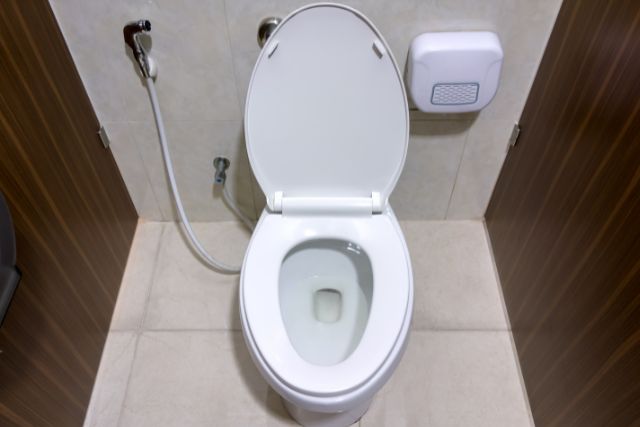
About James
James founded HomeUpgradeLab & was sharing his experiences to fix issues related to bathroom and toilet fixtures & fittings. Read to know more about James Hill & how he started this blog.